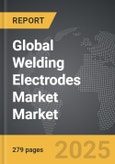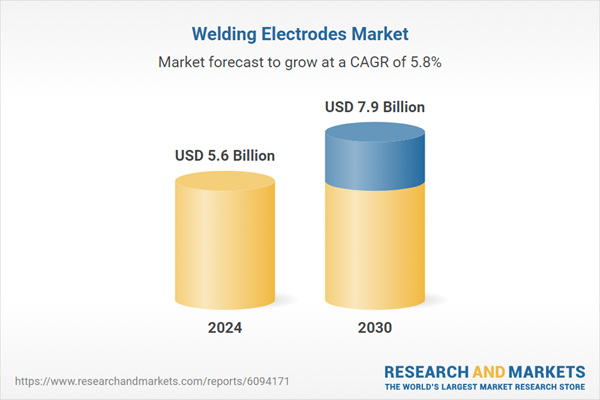Global Welding Electrodes Market - Key Trends & Drivers Summarized
Why Is the Demand for Welding Electrodes Sparking Across Industries?
Welding electrodes are at the heart of numerous industrial processes, with their global market trajectory reflecting rapid evolution in construction, automotive, shipbuilding, and heavy machinery industries. With increasing infrastructure developments worldwide, especially in emerging economies such as India, China, and Brazil, the demand for strong and efficient metal joining techniques has soared, directly boosting the need for various welding electrodes. The construction boom has propelled the demand for coated electrodes, known for their consistent arc and mechanical strength. Simultaneously, automation in welding processes, notably robotic welding, is giving rise to new types of electrodes engineered to optimize performance in automated systems.Innovation in electrode materials, such as the integration of flux cored and metal cored variants, continues to disrupt the traditional market dynamics. These electrodes offer improved deposition rates and better arc stability, making them suitable for high-speed operations - attributes particularly prized in sectors like automotive manufacturing. Environmental regulations are also reshaping the landscape, pushing manufacturers to design low-fume and environmentally safer electrode alternatives. Moreover, the global shift towards sustainable energy and infrastructure is leading to new applications in renewable energy structures and energy-efficient buildings, further widening the scope of the welding electrode market.
What Technological Advancements Are Shaping This Market's Growth?
Technological progress in metallurgy, coating composition, and electrode design has fundamentally transformed the welding electrodes market. Key players are investing in R&D to create intelligent electrodes embedded with sensors for real-time feedback, enhancing weld quality and reducing rework costs. Advances in nanomaterials and alloy development have enabled the production of electrodes with superior tensile strength, thermal resistance, and minimal slag formation. These innovations not only cater to traditional applications but are also enabling new ones such as aerospace components and ultra-high-strength steel joining.Additive manufacturing and 3D printing technologies are making subtle yet significant inroads. These technologies demand specialized welding electrodes for hybrid manufacturing processes where metal deposition plays a critical role. Additionally, the rise of Industry 4.0 has led to the development of electrodes compatible with digitally controlled welding machines, enabling remote diagnostics and predictive maintenance. This convergence of digital and mechanical technologies is anticipated to bring significant efficiencies and drive higher adoption across sectors that were previously slow in adopting new technologies.
Is Geographical Demand Uniform or Are Some Regions Leading the Charge?
Regional dynamics in the global welding electrodes market reveal that Asia Pacific dominates due to its manufacturing-heavy economies and massive infrastructure projects. China, in particular, leads in both production and consumption owing to its expansive steel industry and government-backed initiatives such as the Belt and Road Initiative. India follows closely, driven by government schemes like 'Make in India,' infrastructure modernization, and investments in defense and railways. North America and Europe remain significant markets, though their growth is relatively mature. They are, however, transitioning towards high-tech and environmentally friendly electrode solutions, influenced by stringent environmental norms and the pursuit of energy efficiency.Latin America and Africa, while still nascent, are witnessing a steady uptick in electrode usage due to rising industrialization and urbanization. These regions present lucrative opportunities, especially as global players seek to diversify their markets and tap into unpenetrated territories. The Middle East, propelled by diversification efforts away from oil dependency, is also showing promise in heavy industrial projects, stimulating electrode demand. These regional variations highlight the importance of customized product offerings and tailored market strategies for companies looking to gain competitive advantages across different geographies.
What Forces Are Driving the Expansion of This Market?
The growth in the welding electrodes market is driven by several factors related to technological innovation, end-use expansion, and evolving consumer needs. Technologically, the shift towards high-performance materials that can withstand extreme conditions is encouraging the adoption of advanced electrodes. This includes electrodes capable of welding dissimilar metals or handling high-precision requirements in aerospace and defense sectors. The rising demand for lightweight vehicles is pushing automotive manufacturers to adopt specialized welding techniques, further increasing the consumption of niche electrodes.End-use industries such as oil & gas, marine engineering, and infrastructure are driving sustained demand, with electrodes tailored to their specific operational environments gaining popularity. There's also a strong behavioral trend towards quality and safety, leading buyers to prefer branded, certified electrodes with traceable quality assurance. Urban expansion and mega infrastructure projects globally are reinforcing the baseline demand. In tandem, consumer preferences are shifting toward ready-to-use and low-maintenance products, boosting the sales of easy-strike and low-hydrogen electrodes. Overall, the interplay of these factors is ensuring that the welding electrodes market remains resilient, dynamic, and on an upward trajectory.
Report Scope
The report analyzes the Welding Electrodes market, presented in terms of market value (US$). The analysis covers the key segments and geographic regions outlined below:- Segments: Electrode Type (Stick Electrodes, Coiled Wires Electrodes); End-Use (Automotive, Building & Construction, Oil & Gas, Other End-Uses).
- Geographic Regions/Countries: World; United States; Canada; Japan; China; Europe (France; Germany; Italy; United Kingdom; Spain; Russia; and Rest of Europe); Asia-Pacific (Australia; India; South Korea; and Rest of Asia-Pacific); Latin America (Argentina; Brazil; Mexico; and Rest of Latin America); Middle East (Iran; Israel; Saudi Arabia; United Arab Emirates; and Rest of Middle East); and Africa.
Key Insights:
- Market Growth: Understand the significant growth trajectory of the Stick Electrodes segment, which is expected to reach US$4.5 Billion by 2030 with a CAGR of a 4.6%. The Coiled Wires Electrodes segment is also set to grow at 7.5% CAGR over the analysis period.
- Regional Analysis: Gain insights into the U.S. market, valued at $1.5 Billion in 2024, and China, forecasted to grow at an impressive 8.9% CAGR to reach $1.6 Billion by 2030. Discover growth trends in other key regions, including Japan, Canada, Germany, and the Asia-Pacific.
Why You Should Buy This Report:
- Detailed Market Analysis: Access a thorough analysis of the Global Welding Electrodes Market, covering all major geographic regions and market segments.
- Competitive Insights: Get an overview of the competitive landscape, including the market presence of major players across different geographies.
- Future Trends and Drivers: Understand the key trends and drivers shaping the future of the Global Welding Electrodes Market.
- Actionable Insights: Benefit from actionable insights that can help you identify new revenue opportunities and make strategic business decisions.
Key Questions Answered:
- How is the Global Welding Electrodes Market expected to evolve by 2030?
- What are the main drivers and restraints affecting the market?
- Which market segments will grow the most over the forecast period?
- How will market shares for different regions and segments change by 2030?
- Who are the leading players in the market, and what are their prospects?
Report Features:
- Comprehensive Market Data: Independent analysis of annual sales and market forecasts in US$ Million from 2024 to 2030.
- In-Depth Regional Analysis: Detailed insights into key markets, including the U.S., China, Japan, Canada, Europe, Asia-Pacific, Latin America, Middle East, and Africa.
- Company Profiles: Coverage of players such as Changshu Suhong Machinery Co., Ltd., Eltex of Sweden AB, Fibos Measurement Technology (Changzhou) Co., Ltd., Mahlo GmbH + Co. KG, QINGDAO JINYING MACHINERY CO., LTD. and more.
- Complimentary Updates: Receive free report updates for one year to keep you informed of the latest market developments.
Some of the 42 companies featured in this Welding Electrodes market report include:
- American Welding Products, Inc.
- B&H Electrodes
- Bohler Welding (voestalpine)
- Castolin Eutectic
- Chosun Welding Co., Ltd.
- D&H Sécheron
- ESAB Corporation
- Gedik Welding Inc.
- Hilco Welding
- Hobart Brothers Company
- Hyundai Welding Co., Ltd.
- Kemppi Oy
- Kobe Steel, Ltd. (Kobelco)
- Lincoln Electric Holdings, Inc.
- Miller Electric Mfg. LLC
- Raajratna Electrodes Pvt. Ltd.
- Shandong Welding Materials Co.
- Stanvac-Superon Group
- Thermacut, Inc.
- Zika Industries Ltd.
This edition integrates the latest global trade and economic shifts into comprehensive market analysis. Key updates include:
- Tariff and Trade Impact: Insights into global tariff negotiations across 180+ countries, with analysis of supply chain turbulence, sourcing disruptions, and geographic realignment. Special focus on 2025 as a pivotal year for trade tensions, including updated perspectives on the Trump-era tariffs.
- Adjusted Forecasts and Analytics: Revised global and regional market forecasts through 2030, incorporating tariff effects, economic uncertainty, and structural changes in globalization. Includes historical analysis from 2015 to 2023.
- Strategic Market Dynamics: Evaluation of revised market prospects, regional outlooks, and key economic indicators such as population and urbanization trends.
- Innovation & Technology Trends: Latest developments in product and process innovation, emerging technologies, and key industry drivers shaping the competitive landscape.
- Competitive Intelligence: Updated global market share estimates for 2025, competitive positioning of major players (Strong/Active/Niche/Trivial), and refined focus on leading global brands and core players.
- Expert Insight & Commentary: Strategic analysis from economists, trade experts, and domain specialists to contextualize market shifts and identify emerging opportunities.
Table of Contents
Companies Mentioned (Partial List)
A selection of companies mentioned in this report includes, but is not limited to:
- American Welding Products, Inc.
- B&H Electrodes
- Bohler Welding (voestalpine)
- Castolin Eutectic
- Chosun Welding Co., Ltd.
- D&H Sécheron
- ESAB Corporation
- Gedik Welding Inc.
- Hilco Welding
- Hobart Brothers Company
- Hyundai Welding Co., Ltd.
- Kemppi Oy
- Kobe Steel, Ltd. (Kobelco)
- Lincoln Electric Holdings, Inc.
- Miller Electric Mfg. LLC
- Raajratna Electrodes Pvt. Ltd.
- Shandong Welding Materials Co.
- Stanvac-Superon Group
- Thermacut, Inc.
- Zika Industries Ltd.
Table Information
| Report Attribute | Details |
|---|---|
| No. of Pages | 279 |
| Published | December 2025 |
| Forecast Period | 2024 - 2030 |
| Estimated Market Value ( USD | $ 5.6 Billion |
| Forecasted Market Value ( USD | $ 7.9 Billion |
| Compound Annual Growth Rate | 5.8% |
| Regions Covered | Global |









